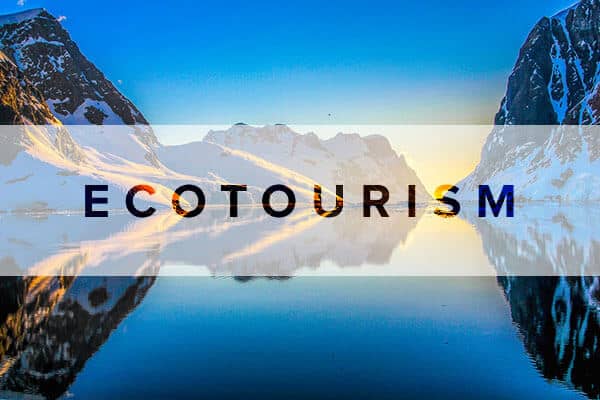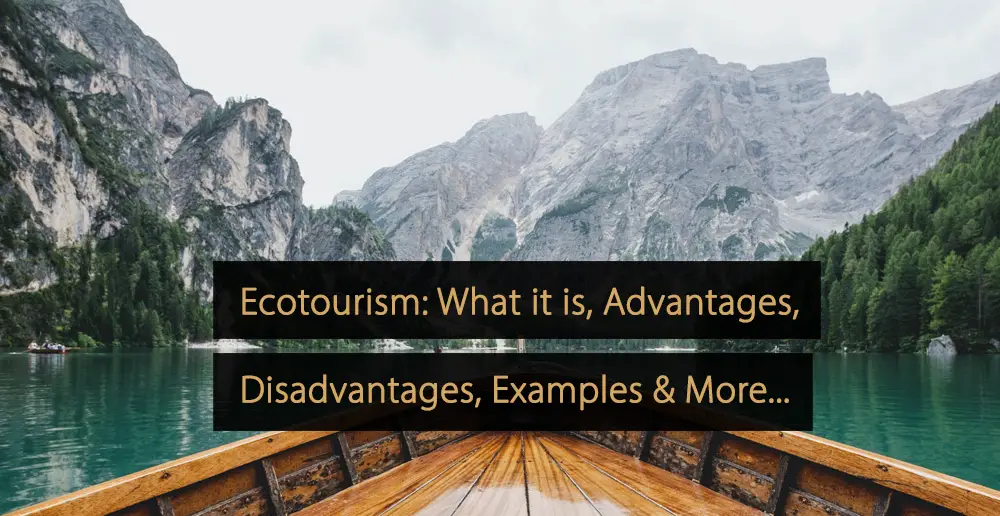Ecotourism, also known as sustainable tourism, is a rapidly growing trend in the travel industry.
An increasing number of travelers are seeking out experiences that do not damage the environment, and support local communities.
These travelers want their tourism to be mutually beneficial for them and the local population.
Ecotourism is seen as a way of creating a balance between economic development, social well-being and environmental protection.

If done right, ecotourism can bring a significant amount of benefits to both the host and the tourist.
Ecotourism aims to minimize the negative impact that tourism is known to have on the environment and maximize the positive impact it can bring.
With this in mind, many destinations around the world have decided to adopt sustainable tourism practices, ensuring that their tourism industry is environmentally, socially, and economically responsible.
- What are the types of Ecotourism?
- What does the term ecotourism mean? Give 3 examples
- What is a good example of ecotourism in the US?
- Where is ecotourism most popular?
- What is the goal of ecotourism?
- What are the 4 principles of ecotourism?
- What are some ecotourism activities?
- Which countries rely on ecotourism?
- Ecotourism advantages and disadvantages
What are the types of Ecotourism?
There are various types of ecotourism, including:
- Wildlife-based ecotourism: This type of ecotourism focuses on observing and interacting with animals in their natural habitats, such as birding or safari tours.
- Adventure-based ecotourism: This type of ecotourism involves activities such as trekking, rafting, and mountain biking in natural landscapes.
- Cultural ecotourism: Also known as community-based ecotourism, this type of ecotourism involves immersing oneself within a particular community and experiencing their traditional ways of living and working.
- Educational ecotourism: This type of ecotourism focuses on learning about the environment and how to preserve it.
- Sustainable ecotourism: This type of ecotourism emphasizes low-impact, environmentally friendly tourism that benefits both the local communities and the environment.
What does the term ecotourism mean? Give 3 examples

Ecotourism refers to responsible travel to natural areas that conserves the environment and improves the well-being of local people.
It is a form of sustainable tourism that focuses on nature-based experiences and encourages conservation efforts.
Three examples of ecotourism are:
- Wildlife safaris in national parks or wildlife reserves – This includes visiting natural areas to observe and learn about wild animals in their natural habitats.
- Coastal and marine ecotourism – This includes activities such as snorkeling, scuba diving, and whale watching tours that promote the conservation of marine life and coastal environments.
- Community-based ecotourism – This involves traveling to remote and rural areas to participate in cultural experiences and support sustainable development initiatives. Examples include staying in local homestays, participating in traditional crafts or workshops, and contributing to conservation efforts.
What is a good example of ecotourism in the US?
One good example of ecotourism in the US is the Everglades National Park in Florida. Visitors can enjoy activities such as hiking, kayaking, birdwatching and boat tours while learning about the importance of preserving the wetlands ecosystem. Check out our article about the best national parks in the world.
The park also offers educational programs and opportunities to volunteer in conservation efforts.
Additionally, local eco-friendly lodges and tour operators allow visitors to minimize their impact on the environment while enjoying their trip.
Where is ecotourism most popular?
Ecotourism is most popular in developing countries with significant natural resources and environmental diversity. Popular ecotourism destinations include Costa Rica, Ecuador, Madagascar, Kenya, and Thailand.
However, ecotourism is also gaining popularity in more developed countries such as Australia, Canada, and the United States.
What is the goal of ecotourism?

The goal of ecotourism is to promote responsible and sustainable tourism that supports conservation efforts and benefits local communities.
It seeks to minimize negative impacts on the environment and culture of the destination while providing visitors with educational and authentic experiences.
Ecotourism aims to raise awareness about environmental issues and encourage visitors to adopt more sustainable practices both during and after their trip. Ultimately, it seeks to balance economic, social, and environmental benefits for all stakeholders involved.
What are the 4 principles of ecotourism?
- Minimizing Impact: Ecotourism aims to minimize the negative impact on the environment and local cultures, including the wildlife, ecosystems, and natural resources. This means ensuring that the activities and experiences provided to tourists do not cause any harm or damage to the natural environment.
- Building Environmental Awareness: Ecotourism emphasizes the importance of environmental conservation and the need to protect and preserve natural resources. Tourists are educated about the local flora and fauna, ecosystems, and cultures, and encouraged to act responsibly to minimize their impact on the environment.
- Providing Positive Feedback: Ecotourism encourages tourists to provide positive feedback to the local communities and businesses that support and maintain the environment. This includes providing positive feedback to the host communities and giving back to local conservation projects or charities.
- Supporting Local Communities: Ecotourism supports the local communities by providing sustainable economic benefits, including employment and income opportunities. By supporting local businesses and enterprises, tourists help to preserve local cultures and traditions, while also contributing to environmental protection efforts.
What are some ecotourism activities?
Some ecotourism activities include:
- Wildlife watching
- Bird watching
- Hiking and trekking
- Scuba diving and snorkeling
- Whale watching
- Mountain biking
- Kayaking and canoeing
- Camping and glamping
- Cultural tours
- Volunteering for conservation projects
- Tree planting and reforestation
- Sustainable agriculture and farming tours
- Geotourism, learning about geology and natural landscapes
- Responsible fishing and sustainable seafood harvesting tours
- Environmental education programs and nature walks.
Which countries rely on ecotourism?

Many countries rely on ecotourism as a source of sustainable and responsible tourism, including:
- Costa Rica
- Ecuador
- Kenya
- Madagascar
- Peru
- Belize
- Brazil
- Australia
- Canada
- Norway
- New Zealand
- Tanzania
- Rwanda
- Switzerland
- Thailand.
Here are a few inspiring examples of destinations that have made significant strides in their sustainable tourism practices:
Costa Rica
Costa Rica, a small Central American country, has been an ecotourism hotspot for over a decade. The country’s government has put in significant efforts to promote sustainable tourism to preserve its natural environment while promoting economic development.
Costa Rica has exceptional biodiversity, and its inhabitants have a strong connection to nature. It is home to over 500,000 plants and animal species, and its government has made considerable efforts to protect the environment. The country generates over 98% of its electricity from renewable sources, and its goal is to achieve carbon neutrality by 2050.
Some of the sustainable tourism practices that Costa Rica has put in place include strict environmental regulations, responsible wildlife viewing, and a certification program for sustainable tourism operators. Visitors can choose from various eco-tourism activities such as eco-lodges, wildlife viewing, and nature hikes through its national park system.
Maasai Mara National Reserve, Kenya
In Africa, Maasai Mara National Reserve is a famous wildlife sanctuary of 1,510 square kilometers. It is located in the southern part of Kenya and is named after the Maasai people who inhabit the region. A significant portion of the tourism in Kenya comes from wildlife-based tourism, and the Maasai Mara is one of the most prominent wildlife destinations in Africa.
Like most wildlife reserves in Africa, tourism has fueled local economic development around the area. However, this tourism can be detrimental if not done sustainably. The Maasai Mara reserve has made significant strides to protect its wildlife while supporting its neighboring communities. The government, conservation organizations, and local communities have collaborated to regulate and monitor the tourism industry and ensure that it benefits both the tourists and the local communities.
Measures have been put in place to minimize the negative impact of tourism on wildlife. Tourists are not allowed to get too close to the animals, and they must use guides who are familiar with the region. To promote sustainable tourism, the authorities have been working hand in hand with the local communities. Programs have been set up to train young people from the local communities to become tour guides, rangers, and even the local representatives in the management committees of the reserves.
Vancouver Island, British Columbia, Canada
Vancouver Island, situated off the west coast of Canada, is well known for its breathtaking natural landscapes, outdoor recreation, and opportunities for ecotourism. The region’s significant tourist attractions include whale watching, bear viewing, and other nature excursions. The Island has been practicing sustainable tourism for over a decade. Tourism Vancouver Island, which regulates and promotes the tourist sector in the region, has been instrumental in ensuring that the tourism industry is sustainable.
Several things have been done to promote sustainable tourism in Vancouver Island; these measures include; the use of biofuel vehicles, the promotion of zero waste, the use of green hotels, and even encouraging visitors to participate in beach clean-ups. The Island’s indigenous culture has also been integrated into the tourism sector. Tourists can participate in cultural tours where they will learn about the region’s history, culture, and traditions.
Interlaken, Switzerland
Interlaken is located in the heart of Switzerland’s picturesque Bernese Oberland region. The town is surrounded by the Alps and is an adventurers paradise. Visitors come in their droves to enjoy a plethora of outdoor activities such as skiing, snowboarding, and hiking, which can be seen as a considerable draw for the region. The town on the other side has also been promoting sustainable tourism to protect the environment while supporting the local economy.
Interlaken has been proactive in putting sustainable tourism practices in place while promoting eco-friendly transport through e-bikes, eco-friendly tour operators, and constructing green-friendly accommodations. The implementation of sustainable practices has resulted in Interlaken’s traditional infrastructure becoming sustainable, which has helped to reduce the negative tourism impact on the environment.
The region has managed to strike a balance between the economic benefits of tourism and the protection of the environment. Local hotels and restaurants have begun to integrate local and organic ingredients into their menus, and some even grow their own food. Interlaken’s sustainable offerings make it ideal for travelers seeking environmentally sustainable experiences.
Bjorkliden, Sweden
Sweden has more than 95,000 lakes, thousands of coastline, and unspoiled forests, which makes eco-tourism a significant attraction in the country. The Bjorkliden mountain village located in the north of Sweden, prides itself on its sustainable tourism practices. The village has stayed true to its commitment to sustainability over the years, and it is a perfect example of how it’s done.
The village is situated in the heart of the spectacular Arctic mountain region, and it is a popular destination for skiing, hiking, and Northern Light watching. What sets the village apart is its commitment to sustainability in every aspect of the tourism value chain. The village is entirely off the grid, and renewable energy powers all its lodges.
The valley has sustainable waste management programs in place, and the community’s drinking water is sourced from a nearby mountain spring. The village’s recycling program goes beyond the usual paper and plastic with even e-waste being recycled. The village also has a policy that requires guest to bring their own towels, which contributes to reducing the carbon footprint.
Ecotourism has become increasingly popular in recent years, and it’s not difficult to see why. These destinations serve as great examples for the rest of the world on how to achieve sustainable tourism while having an environmentally conscious approach. Sustainability is becoming more critical than ever before, and the tourism industry’s contribution to a sustainable future has never been more significant. The future of sustainable tourism remains bright, and it seems like it will only continue to flourish in the years to come.
Ecotourism advantages and disadvantages

Advantages of ecotourism:
- Environmental Preservation: Ecotourism focuses on environmental conservation and protection, which reduces damage to the natural environment and helps to preserve natural resources and ecosystems.
- Education: Ecotourism educates people about conservation efforts and the importance of environmental preservation.
- Economic and Community Development: Ecotourism can provide employment opportunities and stimulate local economies, which can help local communities develop.
- Cultural Preservation: Ecotourism promotes the preservation of cultural heritage and encourages diversity among different communities.
- Sustainable Practices: Ecotourism promotes sustainable practices that help to minimize negative impacts on the environment and preserve resources.
Disadvantages of ecotourism:
- Overcrowding: Ecotourism can sometimes lead to overcrowding in fragile environmental areas, which can have negative impacts on the ecosystem.
- Unsustainable Practices: Ecotourism can sometimes involve unsustainable practices, such as using non-renewable energy sources or large amounts of water.
- Increased Pollution: Increased tourism can lead to increased pollution and waste, which can harm the environment.
- Contraction of Land Use: Land use may be reduced for other potential uses, such as farming or mining, which can have economic impacts on communities.
- Exploitation of resources and people: In some cases, people and resources may be exploited in the name of ecotourism, which can lead to exploitation or human rights abuses.


3 thoughts on “Inspiring Ecotourism Examples from Around the World”